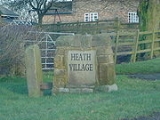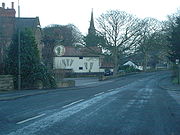
Heath, Derbyshire
Encyclopedia
Heath is a village in the North East Derbyshire
district of the English
county of Derbyshire
.

and the A617 dual carriageway into Chesterfield
.
Close to Heath are the villages of Holmewood
and Temple Normanton
. The village is also near to Stainsby
, host of the annual Stainsby Festival
, and to the Sutton-cum-Duckmanton
civil parish
, which contains several villages, including Sutton Scarsdale
.
As a result of the construction of the M1 Motorway in the 1960s, and more recently the A617 into Chesterfield, many of the linking roads from Heath to its neighbouring villages were severed. These severed roads still exist.
The manor of the village was in the possession of Robert de Ferrars, the First Earl of Derby
, who gave it to the monks of Garendon Abbey. It remained in their possession for almost 400 years. It then became bequeathed by Henry VIII
to Thomas Manners, then to various families following him.
In the village, there are two buildings listed as Grade II, meaning they are of special archeological and historical interest. There is a thatched cottage located near to the entrance of the former Heath Comprehensive School. The second building is the remains of the original 12th century church, which is separated from the village by the dual carriageway.
Much of the village is maintained by the Chatsworth Estate
, with the traditional "Chatsworth Blue" doors and window frames signifying the properties leased from the estate.
The village had a railway station on the Great Central Railway
, which partly followed the route taken by the A617. Both the line and the station closed in the 1960s as part of the 'Beeching axe
'.
The buildings in the village are constructed mainly from the local cream-coloured sandstone
, coupled with a variety of traditional roofing materials. In May 1977, the village was designated a conservation area
.
. Both congregations share the same vicar.
Modern education is provided by Heath Primary School which has stood on the site along Slack Lane since 1867, when boys and girls were taught in separate schools, but now a modern primary with Nursery facilities.
 The village of Heath once hosted a blacksmith, a cobbler, three public houses and a Post Office (closed in November 2009); only The Elm Tree public house and a petrol station on the outskirts of the village now remain. Many of the revamped private residences retain the names of the previous existence, such as The Old Reading Room and Smithy Cottage.
The village of Heath once hosted a blacksmith, a cobbler, three public houses and a Post Office (closed in November 2009); only The Elm Tree public house and a petrol station on the outskirts of the village now remain. Many of the revamped private residences retain the names of the previous existence, such as The Old Reading Room and Smithy Cottage.
North East Derbyshire
North East Derbyshire is a local government district in Derbyshire, England. It borders the districts of Chesterfield, Bolsover, Amber Valley and Derbyshire Dales in Derbyshire, and Sheffield and Rotherham in South Yorkshire....
district of the English
England
England is a country that is part of the United Kingdom. It shares land borders with Scotland to the north and Wales to the west; the Irish Sea is to the north west, the Celtic Sea to the south west, with the North Sea to the east and the English Channel to the south separating it from continental...
county of Derbyshire
Derbyshire
Derbyshire is a county in the East Midlands of England. A substantial portion of the Peak District National Park lies within Derbyshire. The northern part of Derbyshire overlaps with the Pennines, a famous chain of hills and mountains. The county contains within its boundary of approx...
.

Location
Heath is immediately adjacent to junction 29 of the M1 motorwayM1 motorway
The M1 is a north–south motorway in England primarily connecting London to Leeds, where it joins the A1 near Aberford. While the M1 is considered to be the first inter-urban motorway to be completed in the United Kingdom, the first road to be built to motorway standard in the country was the...
and the A617 dual carriageway into Chesterfield
Chesterfield
Chesterfield is a market town and a borough of Derbyshire, England. It lies north of Derby, on a confluence of the rivers Rother and Hipper. Its population is 70,260 , making it Derbyshire's largest town...
.
Close to Heath are the villages of Holmewood
Holmewood
Holmewood is a village in the North East Derbyshire district of Derbyshire, being a former coal mining village with close links to the villages of Heath, North Wingfield and Temple Normanton....
and Temple Normanton
Temple Normanton
Temple Normanton is a village in Derbyshire, England. It is in the North East Derbyshire district of the county.The village sits on a prominent hill top three miles south of Chesterfield. It comprises two villages formerly known as North Normanton and Little Normanton. It is close to the villages...
. The village is also near to Stainsby
Stainsby
Stainsby is a small village in Derbyshire, England. It is near to the towns of Chesterfield and Bolsover, and the villages of Heath and Doe Lea. The M1 motorway skirts past the village....
, host of the annual Stainsby Festival
Stainsby Festival
Stainsby Festival is a small, annual folk music event held in the Derbyshire village of Stainsby, England. It usually takes place in July over three days.The festival is one of the oldest folk festivals in the country, with the first being held in 1969...
, and to the Sutton-cum-Duckmanton
Sutton-cum-Duckmanton
Sutton-cum-Duckmanton is a civil parish in Derbyshire, England, lying between Bolsover and Chesterfield but in the district of North East Derbyshire.The village has a parish church, a pub, 'The Arkwright Arms', and a parish council....
civil parish
Civil parish
In England, a civil parish is a territorial designation and, where they are found, the lowest tier of local government below districts and counties...
, which contains several villages, including Sutton Scarsdale
Sutton Scarsdale
Sutton Scarsdale is a very small village in Derbyshire, England. It is in the North East Derbyshire district. It is very close to the M1 motorway.The settlement is notable for a large, ruined former stately home called Sutton Scarsdale Hall....
.
As a result of the construction of the M1 Motorway in the 1960s, and more recently the A617 into Chesterfield, many of the linking roads from Heath to its neighbouring villages were severed. These severed roads still exist.
History
In the Domesday Survey of 1086, two settlements are recorded around the present location of the village of Heath; they were called Lunt and Le Hethe. The two villages probably combined during the 12/13th century. However, relatively little change has taken place since then; maps from around 1609 show the village in almost its present layout.The manor of the village was in the possession of Robert de Ferrars, the First Earl of Derby
Robert de Ferrers, 1st Earl of Derby
Robert I de Ferrers, 1st Earl of Derby was born in Derbyshire, England, a younger son of Henry de Ferrières and his wife Bertha Roberts . His father, born in Ferrières, Normandy, France accompanied William the Conqueror during his invasion of England...
, who gave it to the monks of Garendon Abbey. It remained in their possession for almost 400 years. It then became bequeathed by Henry VIII
Henry VIII of England
Henry VIII was King of England from 21 April 1509 until his death. He was Lord, and later King, of Ireland, as well as continuing the nominal claim by the English monarchs to the Kingdom of France...
to Thomas Manners, then to various families following him.
In the village, there are two buildings listed as Grade II, meaning they are of special archeological and historical interest. There is a thatched cottage located near to the entrance of the former Heath Comprehensive School. The second building is the remains of the original 12th century church, which is separated from the village by the dual carriageway.
Much of the village is maintained by the Chatsworth Estate
Chatsworth House
Chatsworth House is a stately home in North Derbyshire, England, northeast of Bakewell and west of Chesterfield . It is the seat of the Duke of Devonshire, and has been home to his family, the Cavendish family, since Bess of Hardwick settled at Chatsworth in 1549.Standing on the east bank of the...
, with the traditional "Chatsworth Blue" doors and window frames signifying the properties leased from the estate.
The village had a railway station on the Great Central Railway
Great Central Railway
The Great Central Railway was a railway company in England which came into being when the Manchester, Sheffield and Lincolnshire Railway changed its name in 1897 in anticipation of the opening in 1899 of its London Extension . On 1 January 1923, it was grouped into the London and North Eastern...
, which partly followed the route taken by the A617. Both the line and the station closed in the 1960s as part of the 'Beeching axe
Beeching Axe
The Beeching Axe or the Beeching Cuts are informal names for the British Government's attempt in the 1960s to reduce the cost of running British Railways, the nationalised railway system in the United Kingdom. The name is that of the main author of The Reshaping of British Railways, Dr Richard...
'.
The buildings in the village are constructed mainly from the local cream-coloured sandstone
Sandstone
Sandstone is a sedimentary rock composed mainly of sand-sized minerals or rock grains.Most sandstone is composed of quartz and/or feldspar because these are the most common minerals in the Earth's crust. Like sand, sandstone may be any colour, but the most common colours are tan, brown, yellow,...
, coupled with a variety of traditional roofing materials. In May 1977, the village was designated a conservation area
Conservation area
A conservation areas is a tract of land that has been awarded protected status in order to ensure that natural features, cultural heritage or biota are safeguarded...
.
Customs
The Church of England is represented by All Saints Church, which has close links with St Albans in nearby HolmewoodHolmewood
Holmewood is a village in the North East Derbyshire district of Derbyshire, being a former coal mining village with close links to the villages of Heath, North Wingfield and Temple Normanton....
. Both congregations share the same vicar.
Modern education is provided by Heath Primary School which has stood on the site along Slack Lane since 1867, when boys and girls were taught in separate schools, but now a modern primary with Nursery facilities.
Economy


